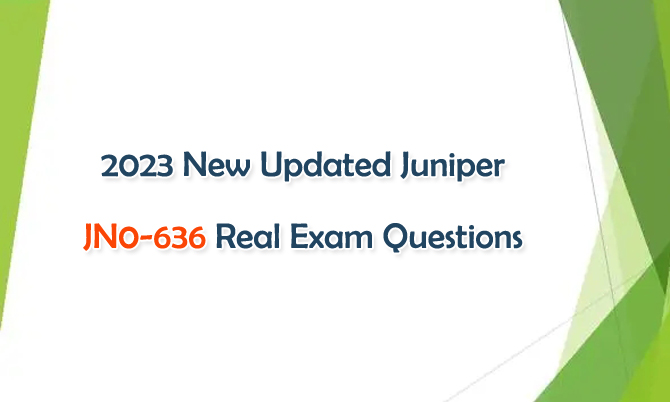Juniper JNCIP-SEC JN0-636 real exam questions have been updated, which are the best material for you to study the test. We all know that JN0-636 exam is a required test for Juniper JNCIP-SEC certification, which is designed for networking professionals with advanced knowledge of the Juniper Networks Junos OS for SRX Series devices. Juniper certification JN0-636 exam verifies your understanding of advanced security technologies and related platform configuration and troubleshooting skills.

Juniper JNCIP-SEC JN0-636 Exam
JN0-636 Security, Professional (JNCIP-SEC) exam basic information is useful in your preparation.
Number of questions: 65 multiple-choice questions
Duration: 90 minutes
Language: English
Test Center: Pearson VUE
Pass/fail status is available immediately after taking the exam.
Juniper JN0-636 Exam Objectives
Juniper certification JN0-636 exam objectives cover the following Security, Professional (JNCIP-SEC) details.
Firewall Filters
Troubleshooting Security Policy and Zones
Advanced Threat Protection
Edge Security
Compliance
Threat Mitigation
Logical and Tenant Systems
Layer 2 Security
Advanced Network Address Translation (NAT)
Advanced IPsec
Share Updated Juniper JN0-636 Real Exam Questions
All the updated Juniper JN0-636 real exam questions are the best material for you to study the above Security, Professional (JNCIP-SEC) topics. Share some updated Juniper JN0-636 real exam questions and answers below.
1.You are connecting two remote sites to your corporate headquarters site; you must ensure that all traffic is secured and
only uses a single Phase 2 SA for both sites. In this scenario, which VPN should be used?
A.An IPsec group VPN with the corporate firewall acting as the hub device.
B.Full mesh IPsec VPNs with tunnels between all sites.
C.A hub-and-spoke IPsec VPN with the corporate firewall acting as the hub device.
D.A full mesh Layer 3 VPN with the corporate firewall acting as the hub device.
Answer: A
2.Which two features would be used for DNS doctoring on an SRX Series firewall? (Choose two.)
A.The DNS ALG must be enabled.
B.static NAT
C.The DNS ALG must be disabled.
D.source NAT
Answer: CD
3.Which method does an SRX Series device in transparent mode use to learn about unknown devices in a network?
A.LLDP-MED
B.IGMP snooping
C.RSTP
D.packet flooding
Answer: A
4.Your Source NAT implementation uses an address pool that contains multiple IPv4 addresses Your users report that when they establish more than one session with an external application, they are prompted to authenticate multiple times External hosts must not be able to establish sessions with internal network hosts. What will solve this problem?
A.Disable PAT.
B.Enable destination NAT.
C.Enable persistent NAT
D.Enable address persistence.
Answer: C
5.You are asked to determine if the 203.0.113.5 IP address has been added to the third-party security feed, DS hield, from Juniper Seclnte1. You have an SRX Series device that is using Seclnte1 feeds from Juniper ATP Cloud. Which command will return this information?
A.show security dynamic---address category---name CC | match 203.0.113.5
B.show security dynamic---address category---name Infected---Hosts | match 203.0.113.5
C.show security dynamic-address category-name IP Filter I match 203.0.113.5
D.show Security dynamic-address category-name JWAS | match 203.0.113.5
Answer: D
